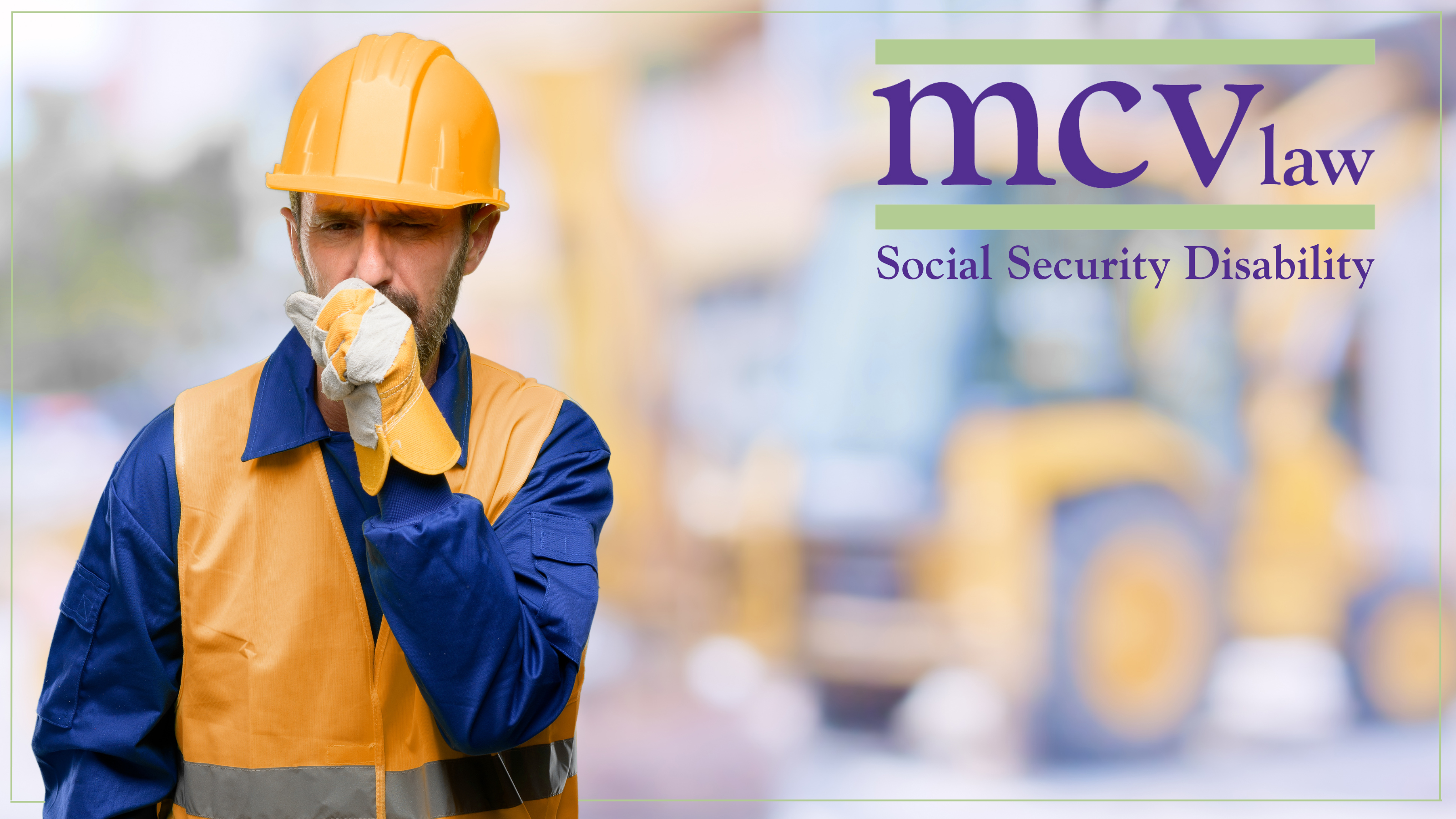
What is Silicosis?
Pneumoconiosis is one of a group of interstitial lung diseases caused by breathing in certain kinds of dust particles that damage your lungs. Because you are likely to encounter these dusts only in the workplace, pneumoconiosis is called an occupational lung disease.
The disease appears in different forms, depending on the type of dust you inhale. Silica can cause pneumoconiosis.
The disease causes scar tissue which may appear on an X-ray as round thickened areas called nodules. If the condition progresses causing a lot of scarring, this is called Fibrosis.
The damage causes the loss of air sacs and blood vessels in your lungs making breathing increasingly difficult. This condition is called interstitial lung disease.
MCV Law understands the severity and challenges associated with this condition, and is here to help you apply for ongoing Social Security Disability benefits.
Schedule Your Free Consultation
How does SSA decide if you qualify for SSD benefits for Silicosis?
The SSA first considers whether your lung disease is severe enough to meet or equal a listing at Step 3 of the sequential evaluation process. If you meet or equal a listing, you are disabled.
If you don’t meet a listing, you may still be found to be disabled depending on your Residual Functional Capacity (RFC).
If you have contracted silicosis, MCV Law's attorneys are here to help you understand your options for benefits and compensation.
Pulmonary Function Studies
Pulmonary function study (PFS) is a general term that applies to any type of respiratory testing. The basic types of PFS are:
- Spirometry
- Arterial Blood Gas Study (ABGS)
- Carbon Monoxide Diffusing Capacity (DLCO)
Does your lung disease meet a listing?
The listing that applies to chronic pulmonary insufficiency is 3.02. It has 4 parts, A, B, C and D.
Part A applies to chronic obstructive pulmonary disease. Part B applies to chronic restrictive ventilator disease. Part C applies to chronic impairment of gas exchange.
Part A of listing 3.02 evaluates the results of spirometry testing of chronic obstructive pulmonary disease due to any cause. You will be found disabled if you have an FEV1 equal to or less than the values listed in Table I corresponding to your age, gender, and height without shoes.
FEV1 is an important measurement for COPD and it decreases in proportion to the severity of the lung disease.
Table I: FEV1 Criteria for 3.02A
|
Height < means |
Height < means |
Table I-A |
Table I-B |
||
|
Age 18 |
Age 20 |
||||
|
Females |
Males |
Females |
Males |
||
|
<153.0 |
<60.25 |
1.20 |
1.45 |
1.05 |
1.20 |
|
153.0 to <159.0 |
60.25 to <62.50 |
1.30 |
1.55 |
1.15 |
1.35 |
|
159.0 to <164.0 |
62.50 to <64.50 |
1.40 |
1.65 |
1.25 |
1.40 |
|
164.0 to <169.0 |
64.50 to <66.50 |
1.45 |
1.75 |
1.35 |
1.50 |
|
169.0 to <174.0 |
66.50 to <68.50 |
1.55 |
1.85 |
1.45 |
1.60 |
|
174.0 to <180.0 |
68.50 to <70.75 |
1.65 |
2.00 |
1.55 |
1.75 |
|
180.0 to <185.0 |
70.75 to <72.75 |
1.75 |
2.10 |
1.65 |
1.85 |
|
185.0 or more |
72.75 or more |
1.80 |
2.15 |
1.70 |
1.90 |
Part B of listing 3.02 evaluates the results of spirometry testing of restrictive pulmonary disease. You will meet the listing for Silicosis if you have an FVC values equal to or less than the values listed in Table II, depending on your age, gender and height without shoes.
Table II: FVC Criteria for 3.02B
|
Height < means |
Height < means |
Table II-A |
Table II-B |
||
|
Age 18 |
Age 20 |
||||
|
Females |
Males |
Females |
Males |
||
|
<153.0 |
<60.25 |
1.35 |
1.65 |
1.30 |
1.50 |
|
153.0 to <159.0 |
60.25 to <62.50 |
1.50 |
1.80 |
1.40 |
1.65 |
|
159.0 to <164.0 |
62.50 to <64.50 |
1.60 |
1.90 |
1.50 |
1.75 |
|
164.0 to <169.0 |
64.50 to <66.50 |
1.70 |
2.05 |
1.60 |
1.90 |
|
169.0 to <174.0 |
66.50 to <68.50 |
1.80 |
2.20 |
1.70 |
2.00 |
|
174.0 to <180.0 |
68.50 to <70.75 |
1.90 |
2.35 |
1.85 |
2.20 |
|
180.0 to <185.0 |
70.75 to <72.75 |
2.05 |
2.50 |
1.95 |
2.30 |
|
185.0 or more |
72.75 or more |
2.10 |
2.60 |
2.00 |
2.40 |
Part C of listing 3.02 measures the impairment of gas exchange demonstrated by DLCO, Arterial PaO2, PaCO2, and SpO2. You will meet part C of the listing if you have a chronic impairment of gas exchange due to your Silicosis.
- DLCO
The average of two unadjusted, single-breath DLCO measurements is less than or equal to the value in Table III for your gender and height without shoes.
Table III: DLCO Criteria for 3.02C1
|
< means |
Height without shoes < means |
Females |
Males |
|
<153.0 |
<60.25 |
8.0 |
9.0 |
|
153.0 to <159.0 |
60.25 to <62.50 |
8.5 |
9.5 |
|
159.0 to <164.0 |
62.50 to <64.50 |
9.0 |
10.0 |
|
164.0 to <169.0 |
64.50 to <66.50 |
9.5 |
10.5 |
|
169.0 to <174.0 |
66.50 to <68.50 |
10.0 |
11.0 |
|
174.0 to <180.0 |
68.50 to <70.75 |
10.5 |
11.5 |
|
180.0 to <185.0 |
70.75 to <72.75 |
11.0 |
12.0 |
|
185.0 or more |
72.75 or more |
11.5 |
12.5 |
- PaO2 and PaCO2
Arterial PaO2 and PaCO2 measured concurrently by an ABG test, while at rest or during steady state exercise, breathing room air less than or equal to the applicable values in Table IV-A, IV-B, or IV-C; or
Tables IV-A, IV-B, and IV-C: ABG Criteria for 3.02C2
|
Table IV-A |
|
|
(Applicable at test sites less than 3,000 feet above sea level) |
|
|
Arterial PaCO2 (mm Hg) and |
Arterial PaO2 less than or equal to (mm Hg) |
|
30 or below |
65 |
|
31 |
64 |
|
32 |
63 |
|
33 |
62 |
|
34 |
61 |
|
35 |
60 |
|
36 |
59 |
|
37 |
58 |
|
38 |
57 |
|
39 |
56 |
|
40 or above |
55 |
|
Table IV-B |
|
|
(Applicable at test sites from 3,000 through 6,000 feet above sea level) |
|
|
Arterial PaCO2 (mm Hg) and |
Arterial PaO2 less than or equal to (mm Hg) |
|
30 or below |
60 |
|
31 |
59 |
|
32 |
58 |
|
33 |
57 |
|
34 |
56 |
|
35 |
55 |
|
36 |
54 |
|
37 |
53 |
|
38 |
52 |
|
39 |
51 |
|
40 or above |
50 |
|
Table IV-C |
|
|
(Applicable at test sites over 6,000 feet above sea level) |
|
|
Arterial PaCO2 (mm Hg) and |
Arterial PaO2 less than or equal to (mm Hg) |
|
30 or below |
55 |
|
31 |
54 |
|
32 |
53 |
|
33 |
52 |
|
34 |
51 |
|
35 |
50 |
|
36 |
49 |
|
37 |
48 |
|
38 |
47 |
|
39 |
46 |
|
40 or above |
45 |
- SpO2
SpO2 measured by pulse oximetry either at rest, during a 6MWT, or after a 6MWT, less than or equal to the value in Table V.
Table V: SpO2 Criteria for 3.02C3
|
Test site altitude (feet above sea level) |
SpO2 less than or equal to |
|
Less than 3,000 |
87 percent |
|
3,000 through 6,000 |
85 percent |
|
Over 6,000 |
83 percent |
- Exacerbations or complications requiring three hospitalizations within 12 months and at least 30 days apart (the 12-month period must occur within the period we are considering in connection with your application or continuing disability review). Each hospitalization must last at least 48 hours, including hours in a hospital emergency department immediately before the hospitalization.
Residual Functional Capacity and Silicosis
If you don’t meet listing 3.02, SSA will need to decide your residual functional capacity to determine the work-related activities you can perform despite your limitations. An RFC for physical impairments is expressed in terms of whether the SSA believes you can do heavy, medium, light, or sedentary work despite your impairment.
Social Security will review your treatment history, your doctor’s opinions, and what functional limitations you have to determine your RFC. Exertional restrictions refer to how much weight you can lift and carry, and how long you can stand/walk or sit. Non-exertional limitations include restrictions on exposure to certain fumes, chemicals, dust, odors, etc., that may aggravate your symptoms.
How Social Security Uses Your RFC
After Social Security has determined your RFC, they compare your RFC to the duties of your past jobs to see if you can still do those jobs. If not, SSA will consider additional factors such as your age, education, and job skills to determine if you can perform other, less physically and/or mentally demanding work.
What other legal options do you have after a silicosis diagnosis?
As silica exposure typically occurs in the workplace, you may also be eligible to receive Worker's Compensation benefits. MCV Law has experienced worker's compensation attorneys who can advise you on whether you have a worker's compensation claim. Our Social Security Disability team works closely with our Worker’s Compensation team to maximize your benefits.
Why Hire an SSDI Lawyer
Applying for disability benefits is a difficult process even when you have a condition that is listed in the Blue Book. Most initial disability claims are denied, and usually, it is due to insufficient evidence or incorrect filing.
When you work with MCV Law, our disability lawyers and dedicated staff will help you file your disability claim appropriately. We will ensure all the proper documents are filed and provided to the SSA on time, including substantial medical evidence that supports your disability.



